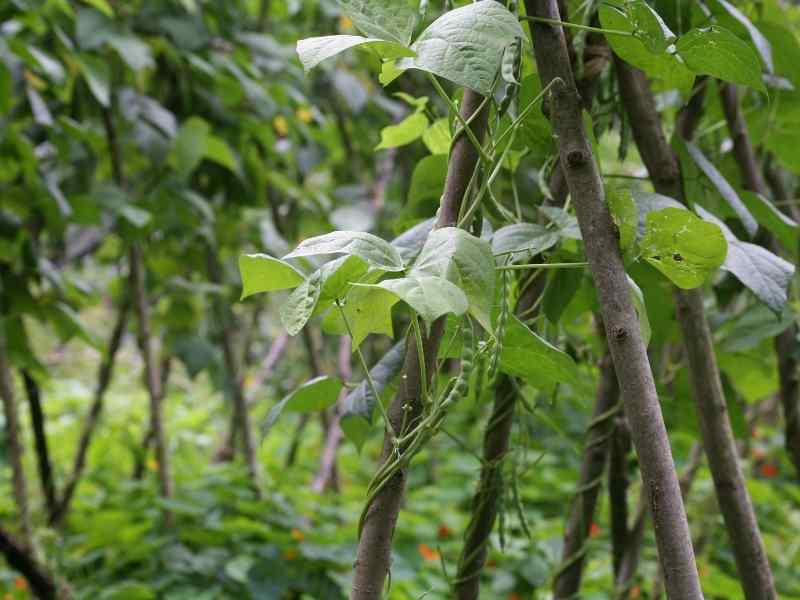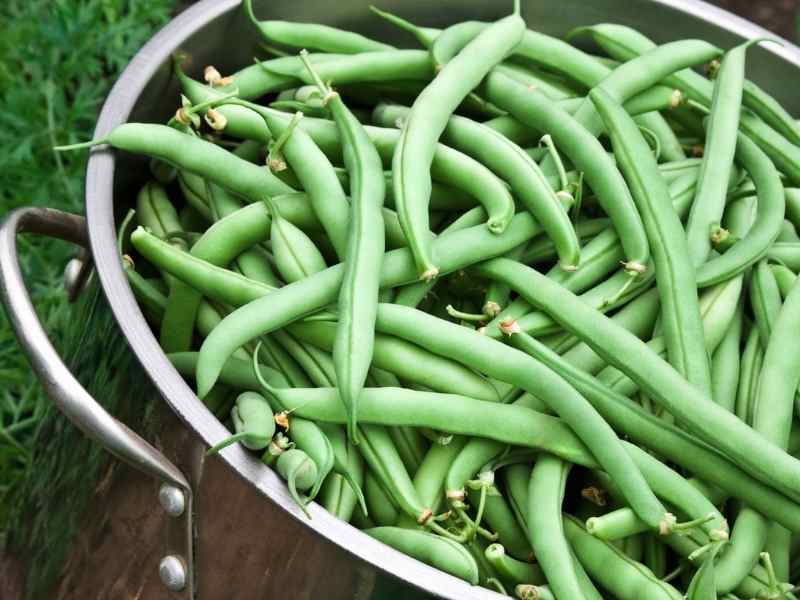Growing beans vertically is rewarding to incorporate this nutritious, tasty veg into the smallest of gardens. A tee pee fully covered in green leaves, delicate flowers, and dripping with beans can be an eye-catching focal point in a food and ornamental garden.

Growing runner beans vertically maximizes the use of a growing area. Successfully growing pole beans on a tee pee structure requires a sunny spot, well prepared soil enriched with organic material, poles and string to build the structure plus bean seeds or seedlings. An irrigation system is optional.
Completing the tee pee in an hour is within most gardeners’ grasp, especially if all the materials are readily on hand. Build it by yourself or grab a friend to help you. See how uncomplicated and fun this project can be!
What Is A Bean Pole Tee Pee?
A tee pee is a structure made from poles bound together at the top with twine or wire. Pole beans grow up and around the structure, as well as across it. The result is an easy-to-manage garden that saves space and keeps the beans off the ground for easier picking.
1. Materials For A Bean Pole Tee Pee
Tee Pees can vary significantly in size and difficulty erecting. Materials listed here are for a structure straightforwardly erected, even by yourself. For more fun, grab a friend. This structure’s size should suit most yards, from small to a generous-sized food garden.
Gather the following items, and your Tee Pee will be done in double-quick time.
- A sunny spot in the garden with well-prepared soil
- Five to eight extra tall bamboo poles or any other tall, straight supports at least 6 – 8 feet high.
- A roll of biodegradable or natural string to tie the poles together at the top and fasten the twigs.
- Permanent marker and tape measure.
- Sticks, twigs, or old vines to which the beans can attach themselves horizontally. (Optionally, the string can be used to fulfill the same function)
- Climbing bean seeds or 6 to 8 seedlings – you can choose to plant an assortment of pole bean types.
- System to water the beans – water by hand or extend an existing system. Wrap a small diameter soaker hose around the base.
- A MUST FOR ANY GARDEN - Make sure your plants grow well with the help of our 8...
- EASY TO INSTALL - Our 0.5 Inch thick bamboo plant stakes can be set up i...
- MULTIPURPOSE STAKES - Aside from being used as plant stakes an supports, our...
Last update on 2024-07-25 / Affiliate links / Images from Amazon Product Advertising API
2. Prepare The Soil:
Beans grow best in slightly acidic or neutral soil with a PH between 5.5 and 7. Add dolomite or wood ash to heavily acidic soil types. Beans grow in most soils and flourish with good drainage and organic material mixed into the ground. Avoid waterlogged soil, which brings on root rot and blossom fall. Let the seed packet be your guide on when and how deep to plant seeds.
3. Build The Tee Pee Structure
The structure should be at least three to four feet in diameter in a rounded shape with poles at least one foot apart.
- Layout the shape with cake flour or a hosepipe. On the circle, mark out where 3, 6, 9 and 12 o’clock would be.
- With the permanent marker, draw a line on each pole, 6 inches from the top. Start by tying a string at the mark of one pole.
- Plant poles into the ground on the marked spots. Anchor them in the soil by pushing them to a depth of between six inches and one foot.
- Tip: Bring all the marks at the top of the poles into line, check that it’s centered, and tie poles together. If your poles have no flex, plant at an angle for them to be gathered at the top.
- Fill in-between with the balance of poles and tie these together until the structure is sturdy.
- To help tendrils get a grip on the tepee, add in horizontal supports.
- This is done by ‘re-purposing dried twigs or vines or with the string you have on hand. Use anything strong enough to support the bean vine.
- The lowest support can be about a foot from the ground, and the rest spaced evenly above that.
The final structure can be as whimsical or as formal looking as you want – that’s part of the beauty of it.
4. Adding Irrigation And Planting Beans:
When using a soaker hose, wrap it around the base of the structure before planting.
- Check the seed packet for detailed planning requirements. Bean seeds are pretty quick to germinate, about 7 to 14 days.
- Plant two seeds per pole and thin out the weaker one as they get going. But, if you are impatient, planting out seedlings against each pole does give faster results. Add a layer of mulch to minimize soil moisture evaporating.
- Loosely tie the seedling plants to the pole to direct growth as they tend to bend over straight after planting. Once they are settled, they will find their own way up, the tendrils winding themselves tightly around the supports.
- Water the seeds or seedlings immediately after planting and keep the soil moist throughout the growing season to encourage continued strong growth, plenty of flowers, and plenty of beans.

Add chards, beets, radish, or strawberries if companion planting. Not only does this help with disorientating potential harmful insects, but it’s also mutually beneficial for growth and utilizes all levels of growing space – root, leafy and fruiting veg.
Harvesting Beans From A Tee Pee
Depending on the variety, pole beans take anywhere from 65 to 85 days to mature. Beans are prolific bearers. The best way to ensure an ongoing crop of beans is to regularly harvest; try every two to three days. The more frequently you gather beans, the longer they produce.
If you planted a variety of pole beans, the show of different color flowers and beans is a feast for the eye, and the cook will thank you too.

Why Grow Beans On A Tepee?
The top three reasons for growing beans vertically on a tee pee structure are also relevant to other structures like a-frame tee pees.
- Beans can take up quite a bit of space to grow to their potential. Growing pole beans vertically provides plenty of room for beans to provide a good harvest.
- Some bean varieties reach heights between 10 and 15 feet tall if not checked. It’s up to you how high you want the supporting structure to be.
- Bean tee pees are a great choice to use in more exposed locations as the wide-bottomed structure can withstand fairly windy conditions.
Final thoughts
Hopefully, this post has shown you that this project is uncomplicated although there are many steps to take.
Putting together a bean pole tee pee of about 6 feet in height is a fast and rewarding activity, even when building it on your own. Including the kids is an excellent way to introduce them to vegetable gardening. They will enjoy helping to search out a sunny spot, digging over the soil, lashing the poles together, and of course, planting the seed or seedlings.
As a final thought, if you would like a unique experience in your garden, build the tee pee large enough and accessible enough to use as a one-of-a-kind photographic backdrop.




